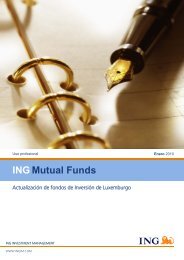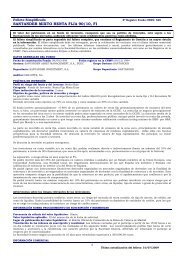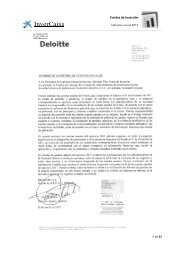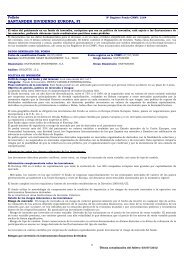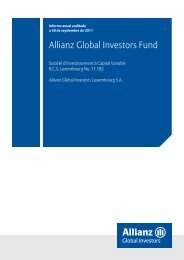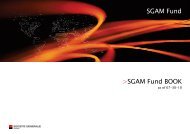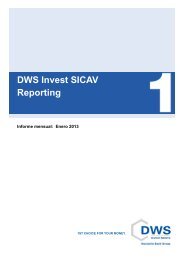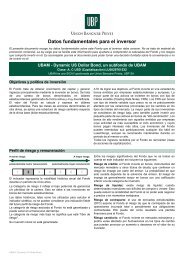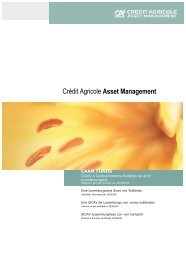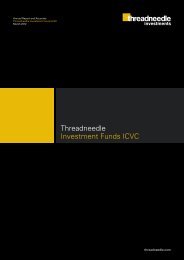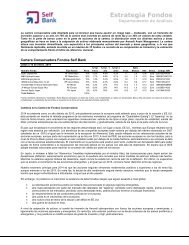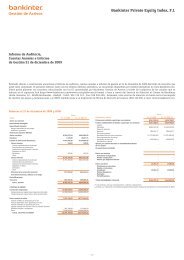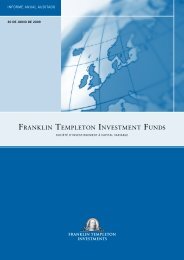Aberdeen Global II - Self Bank
Aberdeen Global II - Self Bank
Aberdeen Global II - Self Bank
- No tags were found...
Create successful ePaper yourself
Turn your PDF publications into a flip-book with our unique Google optimized e-Paper software.
Relative value strategies largely added value by being overweightcheap individual government bond maturities versus more expensiveneighbours on the yield curve. Primarily the cheap issues were thoserecently issued by AOFM.We maintained a modest overweight to credit throughout the wholeyear, having reduced our position somewhat during the early stagesof the Greek crisis in May 2010. Selected issuers with Europeanexposure did not perform as strongly as non-European issuers.All our credit exposure in the Fund is from stronger investment gradeissuers, with no asset rated below AA-/Aa3. We also maintained ouroverweight to semi government securities (semis), primarily issuedby Victoria and Queensland (state-guaranteed). In aggregate, thecredit allocation was a modest negative for performance as swapspreads widened versus government bonds over the review period,offsetting the benefit of superior yieldcarry from non-government assets.OutlookOur view on interest rates has moderated somewhat since lastmonth as we have removed one Reserve <strong>Bank</strong> rate rise fromour profile and pushed back the timing on the expected FederalReserve tightening. Timing aside, however, our most importantchange in view is that the growth/inflation mix is changing, asthe global constraint from higher oil prices has been even greaterthan expected. In addition, we expect this to be a recurring patternwhenever global growth picks up - ie rising demand for oil forcesthe oil price up which acts as a brake on growth - meaning throughtime, growth is likely to be lower and inflation slightly higher. Thisshifting composition is largely indeterminate for nominal rates(as nominal growth remains about the same), but has importantimplications for the allocation decision between nominal andinflation-protected bonds. It is important to emphasise that thisshift is in the context of a global growth outlook which continues tolook acceptable in aggregate. This is due to ongoing accommodativefinancial conditions and in spite of the delicate balances in both theEast (between managing inflation and hard landings) and the West(between stimulus and sustainability) which make for unsteadinessaround the path. Somewhat uniquely, Australia’s rates marketremains hostage to events in other developed economies, in spiteof Australia’s ongoing realignment of growth cycles with Asia.Credit markets in recent months have lost the spread tighteningmomentum that had been in place earlier in 2011. The challengesoccupying the minds of investors stem firstly from the broad slowingof growth seen in the US, Europe and much of Asia, and secondly,from the influence of the rolling European sovereign crisis andparticularly its impact on the banking sector. On the positive side,demand for credit seems to remain strong although it has softenedsince early 2011 and in a historical context, credit spreads are fairlywide, particularly for financial issuers.Undoubtedly some of the weakness in H1 2011 growth has stemmedfrom somewhat temporary factors, such as the Japanese earthquakeand supply chain disruptions and the tax-like effects of higher oiland commodity prices. Those factors can be expected to unwindthrough H2 2011. However, there is evidence of a slowing inforward-looking indicators and it is clear that the US and Europe faceconstraints on growth that will be longer-lasting, such as ongoingprivate sector deleveraging, a reversal of fiscal stimulus generallyand an aggressive fiscal contraction in the EU periphery. Importantlyalso we are in a period of policy tightening from many central banks,with the exception, for now, of the Federal Reserve.Although the last two months have been more difficult for creditmarkets, encouragingly, there was no return to the systemicsovereign and banking sector fears of May/June 2010, despite theGreek crisis. However, the weaker global outlook compared to early2011, along with the loss of spread tightening momentum, leave usfeeling cautious. While we foresee broadly unchanged spreads over12 months, with a slight tightening in our central case, the risks arestill skewed to wider spreads in our alternate scenarios. Our currentmodest overweight to cash credit should remain for the mediumterm though we stand prepared to reduce risk further shouldmarkets deteriorate from here.20 <strong>Aberdeen</strong> <strong>Global</strong> <strong>II</strong>Australian Dollar Bond



